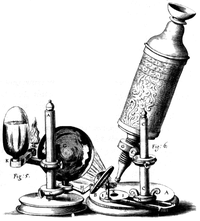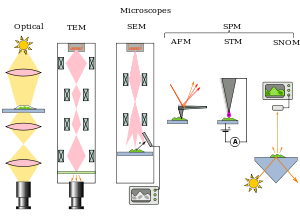 | |
| Uses | Small sample observation |
|---|---|
| Notable experiments | Discovery of cells |
| Inventor | Hans Lippershey Zacharias Janssen |
| Related items | Electron microscope |
A microscope (from the Greek: μικρός, mikrós, "small" and σκοπεῖν, skopeîn, "to look" or "see") is an instrument for viewing objects that are too small to be seen by the naked or unaided eye. The science of investigating small objects using such an instrument is called microscopy. The term microscopic means minute or very small, not visible with the eye unless aided by a microscope. Anton Van Leeuwenhoek's new, improved microscope allowed people to see things no human had ever seen before.
History
Microscopes trace their history back almost 1200 years with Abbas Ibn Firnas's corrective lenses,[1] and it was Ibn al-Haytham's Book of Optics — written between 1011 and 1021 — that laid the foundation for optical research on the magnifying glass. Also, a device called the reading stone by an unknown inventor (thought to be Ibn Firnas) magnified text when laid on top of reading materials.[2]
The first true microscope was made around 1595 in Middelburg, The Netherlands.[3] Three different eyeglass makers have been given credit for the invention: Hans Lippershey (who also developed the first real telescope); Sacharias Jansen; and his son, Zacharias. The coining of the name "microscope" has been credited to Giovanni Faber, who gave that name to Galileo Galilei's compound microscope in 1625.[4] (Galileo had called it the "occhiolino" or "little eye".)
The most common type of microscope—and the first to be invented—is the optical microscope. This is an optical instrument containing one or more lenses that produce an enlarged image of an object placed in the focal plane of the lens(es). There are, however, many other microscope designs.
Types
"Microscopes" can largely be separated into three classes: optical theory microscopes (Light microscope), electron microscopes (e.g.,TEM), and scanning probe microscopes (SPM). Optical microscopes are microscopes which function through the optical theory of lenses in order to magnify the image generated by the passage of a wave through the sample, or reflected by the sample. The waves used are either electromagnetic (in optical microscopes) or electron beams (in electron microscopes). The types are the Compound Light, Stereo, and the electron microscope.
Optical microscopes
Optical microscopes, through their use of visible wavelengths of light, are the simplest and hence most widely used type of microscope. Optical microscopes typically use refractive glass and occasionally of plastic or quartz, to focus light into the eye or another light detector. Mirror-based optical microscopes operate in the same manner. Typical magnification of a light microscope, assuming visible range light, is up to 1500x with a theoretical resolution limit of around 0.2 micrometres or 200 nanometers. Specialized techniques (e.g., scanning confocal microscopy, Vertico SMI) may exceed this magnification but the resolution is diffraction limited. Using shorter wavelengths of light, such as the ultraviolet, is one way to improve the spatial resolution of the microscope as are techniques such as Near-field scanning optical microscope.
Various wavelengths of light, including those beyond the visible range, are sometimes used for special purposes. Ultraviolet light is used to enable the resolution of smaller features as well as to image samples that are transparent to the eye. Near infrared light is used to image circuitry embedded in bonded silicon devices as silicon is transparent in this region. Many wavelengths of light, ranging from the ultraviolet to the visible are used to excite fluorescence emission from objects for viewing by eye or with sensitive cameras.
Phase contrast microscopy is an optical microscopy illumination technique in which small phase shifts in the light passing through a transparent specimen are converted into amplitude or contrast changes in the image. A phase contrast microscope does not require staining to view the slide. This microscope made it possible to study the cell cycle.
The Digital microscope appeared a few years ago, using optics and a charge-coupled device (CCD) camera to output a digital image to a monitor.
Electron microscopes
Three major variants of electron microscopes exist:
- Scanning electron microscope (SEM): looks at the surface of bulk objects by scanning the surface with a fine electron beam and measuring reflection. May also be used for spectroscopy. See also environmental scanning electron microscope
- Transmission electron microscope (TEM): passes electrons completely through the sample, analogous to basic optical microscopy. This requires careful sample preparation, since electrons are scattered so strongly by most materials.This is a scientific device that allows people to see objects that could normally not be seen by the naked or unaided eye.
- Scanning Tunneling Microscope (STM): is a powerful technique for viewing surfaces at the atomic level.
The SEM and STM can also be considered examples of scanning probe microscopy.
Established types of scanning probe microscopy
- AFM, atomic force microscopy
- Contact AFM
- Non-contact AFM
- Dynamic contact AFM
- Tapping AFM
- BEEM, ballistic electron emission microscopy
- EFM, electrostatic force microscope
- ESTM electrochemical scanning tunneling microscope
- FMM, force modulation microscopy
- KPFM, kelvin probe force microscopy
- MFM, magnetic force microscopy
- MRFM, magnetic resonance force microscopy
- NSOM, near-field scanning optical microscopy (or SNOM, scanning near-field optical microscopy)
- PFM, Piezo Force Microscopy
- PSTM, photon scanning tunneling microscopy
- PTMS, photothermal microspectroscopy/microscopy
- SAP, scanning atom probe [5]
- SECM, scanning electrochemical microscopy
- SCM, scanning capacitance microscopy
- SGM, scanning gate microscopy
- SICM, scanning ion-conductance microscopy
- SPSM spin polarized scanning tunneling microscopy
- SThM, scanning thermal microscopy[2]
- STM, scanning tunneling microscopy
- SVM, scanning voltage microscopy
- SHPM, scanning Hall probe microscopy
- SSM, Scanning SQUID microscope
Of these techniques AFM and STM are the most commonly used followed by MFM and SNOM/NSOM.
Other microscopes
Scanning acoustic microscopes use sound waves to measure variations in acoustic impedance. Similar to Sonar in principle, they are used for such jobs as detecting defects in the subsurfaces of materials including those found in integrated circuits.
SEE ALSO- Bright field microscopy
- Condensed Matter Physics
- Confocal microscopy
- Dark field microscopy
- Digital microscope
- Electron Microscope
- Fluorescence interference contrast microscopy
- Fluorescence microscope
- Microscope image processing
- Microscopy
- Optical Microscope
- Intel Play
- Phase contrast microscopy
- Microscope slide
- Telescope
- Timeline of microscope technology
- X-ray microscope
- Microscopy laboratory in: A Study Guide to the Science of Botany at Wikibooks
- Laser capture microdissection
- www.ialo.tk
- www.iass.tk




0 comments:
Post a Comment